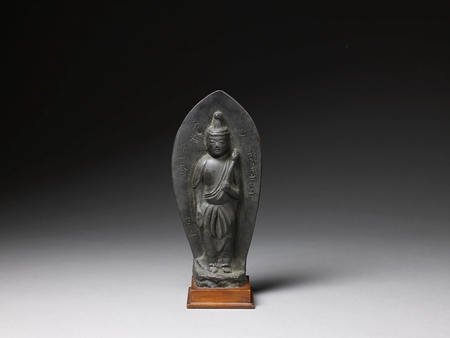Product Description
7681 A bronze figure of Kannon Bosatsu (Guanyin, Avalokiteśvara), wearing flowing robes and holding a lotus flower in the left hand, the right hand in the yogan-in (granting of wishes) mudra, the hair is arranged in a tall standing top knot, standing before a mandorla, with wood stand
Japan 17th century Edo period
Dimensions:
Figure H. 24.5cm x W. 11.3cm x D. 4.5cm (9¾” x 4½” x 2″)
Stand H. 2cm x W. 8.2cm x D. 8cm (1″ x 3¼” x 3¼”)
The mandorla inscribed:
Chichibu sanjuichi ban (Chichibu, no. 31) Shuganji (Shukutsu-ji temple) Kukei
Provenance:
Shukutsu-san Kannon-in temple, Saitama Prefecture, Japan
The inscription indicates that this figure was originally at Shukutsu-san Kannon-in, the 31st temple of the Chichibu 34 Kannon Sanctuary, a pilgrimage route which started in 1234 in the Chichibu area, present-day Saitama Prefecture.
Kannon, the Bodhisattva of mercy, personifies compassion and is one of the most widely worshipped Buddhist divinities in Japan. The name Kannon, meaning ‘watchful listening’ is the shortened version of the original title, Kanzeon, meaning ‘the one who constantly surveys the world listening for the sounds of suffering’.
According to Pure Land Buddhism the task of Kannon is to witness and listen to the prayers and cries of those in difficulty in the earthly realm and to help them achieve salvation. Veneration of Kannon began in Japan in the late 6th century, soon after Buddhism had been introduced to Japan by way of China and Korea. Kannon serves various functions including protecting the Six Realms of Karmic Rebirth, acting as patron of motherhood and children, and protecting the souls of infants lost during childbirth.
The result of Oxford Authentication Ltd thermoluminescence test, N119f87, is consistent with the dating of the object.
n.b This figure was most probably originally revered as a kakebotoke (hanging Buddha), now mounted on a wooden stand as a standing sculpture.







